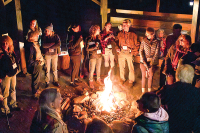End of school year teaches some bad lessons
Each spring as the school year winds down, I can’t decide whether to laugh or cry. As preparations for end-of-year, high-stakes testing get cranked up in our public schools, everything changes.
One day it’s a potentially life-changing test that has even good students stressed out. They are told to get plenty of sleep, eat good and don’t be nervous. Right. Next day it’s a marathon of absolute nothingness, a very “un-educational” experience which for one of my kids involved a three-movie school day. Three movies in one day! Next perhaps is field day or some kind of outdoors day.
My daughter at high school, on the other hand, only goes on test days these last few weeks. I tried to check her out for a dentist appointment the other day and they couldn’t use the intercom to call her. Too disruptive during testing, the logic goes. “Text her, if she’s not testing,” I’m told by front-office personnel.
So it goes without saying that the 180-day school year, to put it kindly, is a joke. And the last 15 days are the funniest of all.
And what kind of encore performance could get cooked up to top the multitude of wasted days and hours at the end of each and every school year? Lucky for us, the powers that be have given us a two-fer: we get to start school in early August to make sure we get enough instructional days in; and two, the Republican-led legislature has decided that public school students should attend school for 185 days, so local school leaders next year get to figure out how to add another five days into a calendar that is already impossible.
My kids go to Haywood County Schools, but it’s the same throughout North Carolina and probably the entire country. Since standardized testing became the wonder drug of accountability for politicians — the measuring stick by which we differentiate good schools from bad schools, and in some cases the tool we use to determine bonuses for educators — we’ve been headed toward the kind of madness that now is the normal for every school year’s end.
Related Items
How mad, you ask? Well, I’ve had teachers tell me that border-line second-graders are being failed because principals and teachers fear their third-grade end-of-grade test scores more than they value their second-grade results and effort. I remember one of my daughters getting taught the “tricks” to help bolster standardized test scores. You know, if you can narrow to two answers, then make a guess. Or, if you have “b” or “d” as choices, pick “d” because studies show that it is more likely to be the right answer based on an average of answers over the last several years (or some such nonsense). Really, this is how to teach elementary students?
The opposite is true for teachers. While students go from total waste to ever-important testing, teachers are trying to test, re-test, find proctors, finish grades, conference with parents, finish paperwork, and wind up a school year in which work days have been cut and planning time shortened.
The great irony in this end-of-year waste of time for students is how it has become the opposite at the beginning of each school year. We keep moving school start dates back toward July in order to get enough days into the school year. I’m all for tough standards to make sure graduating students are prepared for the road ahead, including making sure there is enough instructional time.
Somehow, though, putting students through a couple of wasted weeks at the end of each school year doesn’t jive with the move to start school earlier and earlier. I can’t reconcile the two extremes. I’m looking for answers, and would love to hear from parents, teachers or administrators on this subject.
(Scott McLeod can be reached at This email address is being protected from spambots. You need JavaScript enabled to view it..)













